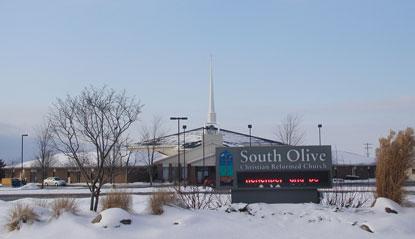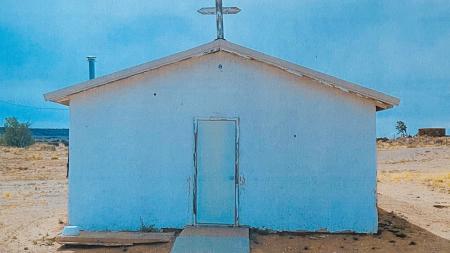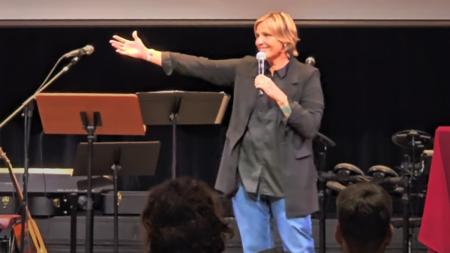South Olive CRC Counts Its Blessings

A lone steeple stands as a reminder of where South Olive Christian Reformed Church had planted itself for more than 100 years.
Just down the road north of Holland, Mich., however, is the new church building, built in the late 1990s. Stained glass windows, wooden trimmings and the bell in the belfry from the old church were incorporated into the new structure.
A clear reminder of many years of tradition is evident in that steeple, which is erected behind a Michigan historical marker. But the past is carried forward in the new church as well.
Taken together, the church and marker are reflective of a congregation, 125 years old this year, that has grown, changed and transformed itself along with the CRC as a whole.
South Olive is emblematic of many small to medium-sized CRC congregations in West Michigan, Iowa and elsewhere. Generations of families have worshipped here, yet new people have been drawn in as well.
About 120 families belong to the church and many of them have children who, it is hoped, will form the next generation of the church. A focus has been placed for many years on ministries that serve young people. In the 1950s, the church played a key role in the creation of a nearby Christian elementary school that remains in existence today.
As with every church, South Olive CRC wrestles with the balance between supporting local ministries and paying the ministry shares that support the denomination's national or global ministries. The recession has made this tougher in recent years.
The CRC's ministry shares program raises about $25 million a year to help support ministries across North America and around the world. Congregations are asked to contribute based on the number of active adult members.
In the past, South Olive paid 100 percent of its ministry share allotment to the local classis and also to the denomination. In recent years they have kept up the commitment to the classis, but the ministry shares they pay to the denomination have dropped somewhat – mostly so they can place emphasis on local ministry in the community.
However, they remain committed to the CRC and do what they can to support the mission of the broader church, both in prayer and in dollars. They do it in other ways as well. Over the years, church members have become CRC pastors. The church also helps fund CRC missionaries.
"We are not a well-heeled congregation, but we are generous," says Rog Brandsen, whose roots in the church go back to its founding. His great-grandparents were charter members, and he has been there all of his life.
Retired now from a boat-building company, the white-bearded Brandsen serves as an elder for the church. "Family ties are still part of this church, and yet we have many new people as well," he says. "The past is the past. Let's remember it, but we're going to live in the present and look to the future."
In the 1950s and 1960s, South Olive had a very popular Bible Club for young people. It still runs a summer Bible camp that draws young people from many churches and communities. A baseball diamond behind the church was built partly for young people to play slow-pitch softball. But other leagues play there as well.

"We see the baseball diamond as a form of ministry," says Rev. Adam Barton, the pastor. "Outreach has always been an important part of this church."
Every month or so, the youth put on the evening service. Currently, the church is experimenting with allowing the youth to use the church parsonage for their activities. Barton lives with his wife and children in their own home in nearby Borculo.
"Young people are often the ones who push things and we need to listen to them," says Barton. "We want to empower our youth to have an active part in the church."
There are adult ministries as well, including adult classes and Bible studies. The church also has an active Family Night on Wednesdays with an adult Bible study in addition to GEMS, Cadets, and Bible Club for children.
South Olive also helps run a food distribution program to those in need, a clothing ministry for a struggling CRC congregation in Allegan County, and a pie ministry begun by women of the church to help pay off the mortgage on the new church that has continued even after the church was paid off.
Women gather once a week to make and bake pies, often up to 90 at a time, which are sold as a church fund-raising effort to church members and to anyone else who has a hankering for a homemade pie. There are 10 varieties in all.
Rev. Jerry Dykstra, executive director of the CRC, visited the church recently for its 125th anniversary service. He says he was pleased to see how healthy and vibrant it is. There are many churches in the denomination like this one, Dykstra said, but he was moved by the "engaging spirit" of South Olive.
Among the first CRC congregations to be formed in the late 1880s, South Olive was for many years the spiritual home for farming families, many of whom emigrated from the Netherlands. That changed dramatically around the time of World War II and has been changing ever since as farming has become only one of the ways in which people can make a living in the area.
Another big change came in the mid 1990s when a group from the church left over issues confronting the CRC and joined a new church. Pain from that time still lingers.
"Out of that difficult time, two healthy congregations have emerged," says Barton. “We have joined together in recent years in a variety of joint services, a sign that healing is taking place.”
Pastor Barton describes worship at South Olive as "blended."
"We value the hymns and language of the past, but include contemporary styles and imagery as well. The priority in both our morning and evening services is to encounter God in Word and worship in a way that transforms us and our community."
Overarching it all, says Brandsen, are strong ties to the denomination, which can do bigger types of ministry than a small church can do on its own.
"The CRC has done a great job over the years by reaching out to the world," says Brandsen. "We are proud to be part of that. Denominational identity is very important to the people of this church. We are part of something bigger than just our church."


